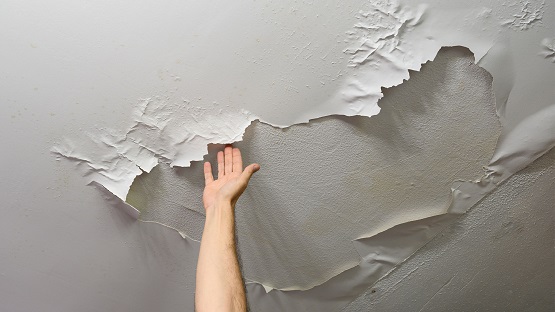The presence of dampness on the roof of a home can become a problem. Besides affecting the aesthetic appearance, it can represent a risk to the safety and health of the people who live in it. The roof is one of the essential elements in any house. They provide security and thermal insulation and protect the interior from rain, weather, and other natural agents.

Table of Contents
Cracks and holes in the ceiling
Fissures and cracks are among the most common causes of moisture in ceilings. Generally, this problem starts with a small break, which will grow if you do not hire a professional roofing contractor on time.Cracks are often challenging to find with the naked eye.
Broken roof tiles
What relationship can a broken tile have with humidity? The function of the tiles is to protect the roof surface from the weather and rainwater. If it is broken, there is no protection. When a shingle breaks, it creates a gap through which rainwater can directly contact the roof or roof liner.
Plumbing problems
A water leak in one of the pipes behind the walls or the ceiling can be a real headache. When these problems exist, the water seeps into the walls or ceiling, leaving damp spots.
Condensation
In the case of having rooms with little air circulation inside the house, the chances of dampness appearing due to condensation on the ceiling are greater. Without an escape route, moisture accumulates on the surface of the roof and walls, causing corrosion and damage to materials.
Poor waterproofing
The use of poor quality waterproofing materials and a flawed construction process can cause water to be able to penetrate the waterproofing and cause damage due to moisture accumulation.
What are the consequences of humidity in the ceiling?
The presence of moisture on the ceiling and inside a home is not something you should overlook under any circumstances.
- The proliferation of mold, mites, and fungi in the affected areas
- Moisture stains and paint peeling
- Health problems related to respiratory conditions, as well as allergies and other diseases
- Detachment of the structural elements of the roof
- Other structural pathologies
How to prevent moisture-related problems
Preventing the proliferation of humidity is the best way to save money on repairs and avoid putting the health and safety of the inhabitants of the house at risk. How do you inspect your roof?
Avoid clogged gutters
If you have a sloped roof, you should know that rainwater and snowfall would drain through the gutters. For this reason, it is crucial to keep the gutter clean and free of leaves and other debris.
Ensures good ventilation
To avoid humidity due to condensation, it is necessary to improve the ventilation inside the house.
Apply a protective treatment to the roof
To avoid problems with humidity in the future, it is best to ensure that the roof is in perfect condition and is capable of withstanding rain without accumulating moisture. Apply a waterproof and water-repellent treatment to its surface.
You should contact professionals right now to ensure that moisture will not appear due to any of the factors mentioned above.






